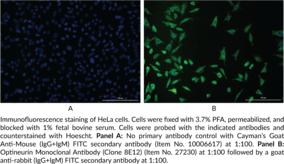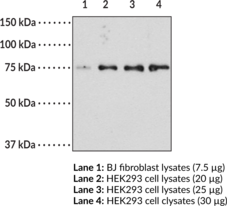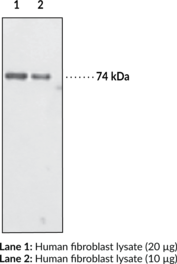Cayman
Showing 33301–33450 of 45550 results
-
ONO-7300243 is an antagonist of lysophosphatidic acid receptor 1 (LPA1; IC50 = 0.16 µM).{43205} It is selective for LPA1 over the LPA2 and LPA3 receptors (IC50s = 8.6 and >10 µM, respectively). ONO-7300243 dose-dependently reduces intraurethral pressure induced by LPA in rats (ID50 = 11.6 mg/kg) without affecting mean blood pressure.
Brand:CaymanSKU:22052 -Out of stock
ONO-7300243 is an antagonist of lysophosphatidic acid receptor 1 (LPA1; IC50 = 0.16 µM).{43205} It is selective for LPA1 over the LPA2 and LPA3 receptors (IC50s = 8.6 and >10 µM, respectively). ONO-7300243 dose-dependently reduces intraurethral pressure induced by LPA in rats (ID50 = 11.6 mg/kg) without affecting mean blood pressure.
Brand:CaymanSKU:22052 -Out of stock
ONO-7300243 is an antagonist of lysophosphatidic acid receptor 1 (LPA1; IC50 = 0.16 µM).{43205} It is selective for LPA1 over the LPA2 and LPA3 receptors (IC50s = 8.6 and >10 µM, respectively). ONO-7300243 dose-dependently reduces intraurethral pressure induced by LPA in rats (ID50 = 11.6 mg/kg) without affecting mean blood pressure.
Brand:CaymanSKU:22052 -Out of stock
ONO-7300243 is an antagonist of lysophosphatidic acid receptor 1 (LPA1; IC50 = 0.16 µM).{43205} It is selective for LPA1 over the LPA2 and LPA3 receptors (IC50s = 8.6 and >10 µM, respectively). ONO-7300243 dose-dependently reduces intraurethral pressure induced by LPA in rats (ID50 = 11.6 mg/kg) without affecting mean blood pressure.
Brand:CaymanSKU:22052 -Out of stock
ONO-8130 is an orally bioavailable antagonist of the prostaglandin E2 (PGE2) receptor EP1 (Ki = 1.9 nM){31234,22585} It exerts a more than 1,000-fold selectivity for EP1 compared with other EP receptors.{22585} ONO-8130 suppresses pain associated with cyclophosphamide-induced cystitis in mice at 0.3-30 mg/kg.{31234} It also blocks PGE2-induced contraction and eliminates spontaneous tone of guinea pig trachea tested in tissue organ baths.{22585}
Brand:CaymanSKU:-Available on backorder
ONO-8130 is an orally bioavailable antagonist of the prostaglandin E2 (PGE2) receptor EP1 (Ki = 1.9 nM){31234,22585} It exerts a more than 1,000-fold selectivity for EP1 compared with other EP receptors.{22585} ONO-8130 suppresses pain associated with cyclophosphamide-induced cystitis in mice at 0.3-30 mg/kg.{31234} It also blocks PGE2-induced contraction and eliminates spontaneous tone of guinea pig trachea tested in tissue organ baths.{22585}
Brand:CaymanSKU:-Available on backorder
ONO-8130 is an orally bioavailable antagonist of the prostaglandin E2 (PGE2) receptor EP1 (Ki = 1.9 nM){31234,22585} It exerts a more than 1,000-fold selectivity for EP1 compared with other EP receptors.{22585} ONO-8130 suppresses pain associated with cyclophosphamide-induced cystitis in mice at 0.3-30 mg/kg.{31234} It also blocks PGE2-induced contraction and eliminates spontaneous tone of guinea pig trachea tested in tissue organ baths.{22585}
Brand:CaymanSKU:-Available on backorder
ONO-8130 is an orally bioavailable antagonist of the prostaglandin E2 (PGE2) receptor EP1 (Ki = 1.9 nM){31234,22585} It exerts a more than 1,000-fold selectivity for EP1 compared with other EP receptors.{22585} ONO-8130 suppresses pain associated with cyclophosphamide-induced cystitis in mice at 0.3-30 mg/kg.{31234} It also blocks PGE2-induced contraction and eliminates spontaneous tone of guinea pig trachea tested in tissue organ baths.{22585}
Brand:CaymanSKU:-Available on backorder
Prostaglandin E2 (PGE2) initiates its cellular effects by activating one of four E prostanoid (EP) receptors, EP1-4. ONO-8711 is a potent and selective competitive antagonist of the EP1 receptor (Ki = 0.6 and 1.7 nM for human and mouse EP1, respectively, versus 67 and 76 nM for mouse EP3 and human thromboxane receptor, respectively, and >1,000 nM for other receptors).{7415} ONO-8711 effectively reduces tumor incidence and multiplicity in mouse models of colon, breast, and oral cancer.{7415,10246,19682} It also suppresses pain and acid-induced HCO3- secretion in the stomach.{10093,19683,19684}
Brand:CaymanSKU:-Prostaglandin E2 (PGE2) initiates its cellular effects by activating one of four E prostanoid (EP) receptors, EP1-4. ONO-8711 is a potent and selective competitive antagonist of the EP1 receptor (Ki = 0.6 and 1.7 nM for human and mouse EP1, respectively, versus 67 and 76 nM for mouse EP3 and human thromboxane receptor, respectively, and >1,000 nM for other receptors).{7415} ONO-8711 effectively reduces tumor incidence and multiplicity in mouse models of colon, breast, and oral cancer.{7415,10246,19682} It also suppresses pain and acid-induced HCO3- secretion in the stomach.{10093,19683,19684}
Brand:CaymanSKU:-Prostaglandin E2 (PGE2) initiates its cellular effects by activating one of four E prostanoid (EP) receptors, EP1-4. ONO-8711 is a potent and selective competitive antagonist of the EP1 receptor (Ki = 0.6 and 1.7 nM for human and mouse EP1, respectively, versus 67 and 76 nM for mouse EP3 and human thromboxane receptor, respectively, and >1,000 nM for other receptors).{7415} ONO-8711 effectively reduces tumor incidence and multiplicity in mouse models of colon, breast, and oral cancer.{7415,10246,19682} It also suppresses pain and acid-induced HCO3- secretion in the stomach.{10093,19683,19684}
Brand:CaymanSKU:-Prostaglandin E2 (PGE2) initiates its cellular effects by activating one of four E prostanoid (EP) receptors, EP1-4. ONO-8711 is a potent and selective competitive antagonist of the EP1 receptor (Ki = 0.6 and 1.7 nM for human and mouse EP1, respectively, versus 67 and 76 nM for mouse EP3 and human thromboxane receptor, respectively, and >1,000 nM for other receptors).{7415} ONO-8711 effectively reduces tumor incidence and multiplicity in mouse models of colon, breast, and oral cancer.{7415,10246,19682} It also suppresses pain and acid-induced HCO3- secretion in the stomach.{10093,19683,19684}
Brand:CaymanSKU:-ONO-AE3-208 is an antagonist of the EP4 receptor (Ki = 1.3 nM) which less potently affects EP3, FP, and TP receptors (Kis = 30, 790, and 2,400 nM, respectively) and is without effect on other prostanoid receptors.{26174,26175} In wild type mice, it mimics deletion of EP4 by producing severe colitis, with epithelial loss, crypt damage, and inflammation, after treatment with 3% dextran sodium sulfate.{26174} ONO-AE3-208 has also been used to implicate EP4 signaling in immune and autoimmune responses, inflammation, and cancer.{14694,12718,18605,23308}
Brand:CaymanSKU:-ONO-AE3-208 is an antagonist of the EP4 receptor (Ki = 1.3 nM) which less potently affects EP3, FP, and TP receptors (Kis = 30, 790, and 2,400 nM, respectively) and is without effect on other prostanoid receptors.{26174,26175} In wild type mice, it mimics deletion of EP4 by producing severe colitis, with epithelial loss, crypt damage, and inflammation, after treatment with 3% dextran sodium sulfate.{26174} ONO-AE3-208 has also been used to implicate EP4 signaling in immune and autoimmune responses, inflammation, and cancer.{14694,12718,18605,23308}
Brand:CaymanSKU:-ONO-AE3-208 is an antagonist of the EP4 receptor (Ki = 1.3 nM) which less potently affects EP3, FP, and TP receptors (Kis = 30, 790, and 2,400 nM, respectively) and is without effect on other prostanoid receptors.{26174,26175} In wild type mice, it mimics deletion of EP4 by producing severe colitis, with epithelial loss, crypt damage, and inflammation, after treatment with 3% dextran sodium sulfate.{26174} ONO-AE3-208 has also been used to implicate EP4 signaling in immune and autoimmune responses, inflammation, and cancer.{14694,12718,18605,23308}
Brand:CaymanSKU:-ONO-AE3-208 is an antagonist of the EP4 receptor (Ki = 1.3 nM) which less potently affects EP3, FP, and TP receptors (Kis = 30, 790, and 2,400 nM, respectively) and is without effect on other prostanoid receptors.{26174,26175} In wild type mice, it mimics deletion of EP4 by producing severe colitis, with epithelial loss, crypt damage, and inflammation, after treatment with 3% dextran sodium sulfate.{26174} ONO-AE3-208 has also been used to implicate EP4 signaling in immune and autoimmune responses, inflammation, and cancer.{14694,12718,18605,23308}
Brand:CaymanSKU:-ONO-RS-082 is a reversible inhibitor of Ca2+-independent phospholipase A2.{32316} At 3.5 µM, it has been shown to inhibit epinephrine-stimulated thromboxane production in human platelets.{32316} ONO-RS-082 can also disrupt endosome tubule formation and maintenance of the Golgi complex.{9879,32317}
Brand:CaymanSKU:20243 -Available on backorder
ONO-RS-082 is a reversible inhibitor of Ca2+-independent phospholipase A2.{32316} At 3.5 µM, it has been shown to inhibit epinephrine-stimulated thromboxane production in human platelets.{32316} ONO-RS-082 can also disrupt endosome tubule formation and maintenance of the Golgi complex.{9879,32317}
Brand:CaymanSKU:20243 -Available on backorder
Ononin is a glycoside isoflavone that has been found in soybeans and A. mongholicus and has anti-inflammatory and neuroprotective activities.{42797,42798,42799} Ononin (5 µM) inhibits LPS-induced production of nitrite, prostaglandin E2 (PGE2; Item No. 14010), and the pro-inflammatory cytokines IL-1β, IL-6, and TNF-α by RAW 264.7 macrophages.{42799} It also inhibits glutamate-induced toxicity in rat adrenal PC12 cells when used at a concentration of 0.025 µg/ml.{42798}
Brand:CaymanSKU:27046 - 10 mgAvailable on backorder
Ononin is a glycoside isoflavone that has been found in soybeans and A. mongholicus and has anti-inflammatory and neuroprotective activities.{42797,42798,42799} Ononin (5 µM) inhibits LPS-induced production of nitrite, prostaglandin E2 (PGE2; Item No. 14010), and the pro-inflammatory cytokines IL-1β, IL-6, and TNF-α by RAW 264.7 macrophages.{42799} It also inhibits glutamate-induced toxicity in rat adrenal PC12 cells when used at a concentration of 0.025 µg/ml.{42798}
Brand:CaymanSKU:27046 - 25 mgAvailable on backorder
Ononin is a glycoside isoflavone that has been found in soybeans and A. mongholicus and has anti-inflammatory and neuroprotective activities.{42797,42798,42799} Ononin (5 µM) inhibits LPS-induced production of nitrite, prostaglandin E2 (PGE2; Item No. 14010), and the pro-inflammatory cytokines IL-1β, IL-6, and TNF-α by RAW 264.7 macrophages.{42799} It also inhibits glutamate-induced toxicity in rat adrenal PC12 cells when used at a concentration of 0.025 µg/ml.{42798}
Brand:CaymanSKU:27046 - 5 mgAvailable on backorder
Ononin is a glycoside isoflavone that has been found in soybeans and A. mongholicus and has anti-inflammatory and neuroprotective activities.{42797,42798,42799} Ononin (5 µM) inhibits LPS-induced production of nitrite, prostaglandin E2 (PGE2; Item No. 14010), and the pro-inflammatory cytokines IL-1β, IL-6, and TNF-α by RAW 264.7 macrophages.{42799} It also inhibits glutamate-induced toxicity in rat adrenal PC12 cells when used at a concentration of 0.025 µg/ml.{42798}
Brand:CaymanSKU:27046 - 50 mgAvailable on backorder
ONT-093 is an orally bioavailable substituted diarylimidazole inhibitor of P-glycoprotein ATPase activity (IC50 = 0.16 µM).{48625} It reverses drug resistance to doxorubicin (Item No. 15007), vinblastine (Item No. 11762), and paclitaxel (Item No. 10461) in human lymphoma, breast, ovarian, uterine, and colorectal cancer cell lines in vitro (EC50s = 9-38 nM). It is not cytotoxic to 15 normal, non-transformed, or tumor cell lines when used at concentrations up to 100 µM and exhibits weak cytostatic activity (average IC50 = >60 µM). ONT-093 (30 mg/kg) reverses paclitaxel drug resistance in an HCT15 human colon carcinoma mouse xenograft model.
Brand:CaymanSKU:28758 - 1 mgAvailable on backorder
ONT-093 is an orally bioavailable substituted diarylimidazole inhibitor of P-glycoprotein ATPase activity (IC50 = 0.16 µM).{48625} It reverses drug resistance to doxorubicin (Item No. 15007), vinblastine (Item No. 11762), and paclitaxel (Item No. 10461) in human lymphoma, breast, ovarian, uterine, and colorectal cancer cell lines in vitro (EC50s = 9-38 nM). It is not cytotoxic to 15 normal, non-transformed, or tumor cell lines when used at concentrations up to 100 µM and exhibits weak cytostatic activity (average IC50 = >60 µM). ONT-093 (30 mg/kg) reverses paclitaxel drug resistance in an HCT15 human colon carcinoma mouse xenograft model.
Brand:CaymanSKU:28758 - 10 mgAvailable on backorder
ONT-093 is an orally bioavailable substituted diarylimidazole inhibitor of P-glycoprotein ATPase activity (IC50 = 0.16 µM).{48625} It reverses drug resistance to doxorubicin (Item No. 15007), vinblastine (Item No. 11762), and paclitaxel (Item No. 10461) in human lymphoma, breast, ovarian, uterine, and colorectal cancer cell lines in vitro (EC50s = 9-38 nM). It is not cytotoxic to 15 normal, non-transformed, or tumor cell lines when used at concentrations up to 100 µM and exhibits weak cytostatic activity (average IC50 = >60 µM). ONT-093 (30 mg/kg) reverses paclitaxel drug resistance in an HCT15 human colon carcinoma mouse xenograft model.
Brand:CaymanSKU:28758 - 5 mgAvailable on backorder
ONX 0912 is an orally bioavailable proteasome inhibitor.{28242} It potently targets the chymotrypsin-like activity of the 20S proteasome subunits β5 and LMP7 (IC50s = 36 and 82 nM, respectively).{28242} ONX 0912 inhibits the growth of multiple myeloma cells at nanomolar concentrations while not decreasing the viability of normal peripheral blood mononuclear cells at 1 µM.{28245} It blocks the growth of xenografted human multiple myeloma cells in mice when given orally.{28245} ONX 0912 has potential applications in certain types of cancer as well as other diseases that require proteasome activity.{28240,28241,28243,28244}
Brand:CaymanSKU:-ONX 0912 is an orally bioavailable proteasome inhibitor.{28242} It potently targets the chymotrypsin-like activity of the 20S proteasome subunits β5 and LMP7 (IC50s = 36 and 82 nM, respectively).{28242} ONX 0912 inhibits the growth of multiple myeloma cells at nanomolar concentrations while not decreasing the viability of normal peripheral blood mononuclear cells at 1 µM.{28245} It blocks the growth of xenografted human multiple myeloma cells in mice when given orally.{28245} ONX 0912 has potential applications in certain types of cancer as well as other diseases that require proteasome activity.{28240,28241,28243,28244}
Brand:CaymanSKU:-ONX 0912 is an orally bioavailable proteasome inhibitor.{28242} It potently targets the chymotrypsin-like activity of the 20S proteasome subunits β5 and LMP7 (IC50s = 36 and 82 nM, respectively).{28242} ONX 0912 inhibits the growth of multiple myeloma cells at nanomolar concentrations while not decreasing the viability of normal peripheral blood mononuclear cells at 1 µM.{28245} It blocks the growth of xenografted human multiple myeloma cells in mice when given orally.{28245} ONX 0912 has potential applications in certain types of cancer as well as other diseases that require proteasome activity.{28240,28241,28243,28244}
Brand:CaymanSKU:-The immunoproteasome is a specialized, inducible proteasome that generates peptides presented on major histocompatibility complex (MHC) class I molecules to cytotoxic T cells. Stimulation of cells with inflammatory cytokines such as IFN-γ leads to the replacement of constitutive catalytic proteasome β subunits with inducible β subunits (β1i (LMP2), β2i (MECL1), and β5i (LMP7)), which are required for the production of certain MHC class I-restricted T cell epitopes. ONX 0914 is a selective inhibitor of the β5i (LMP7) subunit of the immunoproteasome (IC50s = 65 and 73 nM for mouse and human, respectively) and demonstrates significantly weaker activity at the β5 subunit of the constitutive proteasome (IC50s = 0.92 and 1.04 µM for mouse and human, respectively).{28373,28369} It can block the production of IL-23 by activated monocytes and the production of IFN-γ and IL-2 by T cells.{28373} ONX 0914 can also inhibit IL-17-producing T cells under TH17-polarizing conditions in vitro and reduce TH1 and TH17 cell differentiation in vivo.{28372} This compound has been shown to attenuate disease progression in several experimental models of autoimmune disorders as well as in some hematologic malignancies.{28373,28370,28241,28371}
Brand:CaymanSKU:-The immunoproteasome is a specialized, inducible proteasome that generates peptides presented on major histocompatibility complex (MHC) class I molecules to cytotoxic T cells. Stimulation of cells with inflammatory cytokines such as IFN-γ leads to the replacement of constitutive catalytic proteasome β subunits with inducible β subunits (β1i (LMP2), β2i (MECL1), and β5i (LMP7)), which are required for the production of certain MHC class I-restricted T cell epitopes. ONX 0914 is a selective inhibitor of the β5i (LMP7) subunit of the immunoproteasome (IC50s = 65 and 73 nM for mouse and human, respectively) and demonstrates significantly weaker activity at the β5 subunit of the constitutive proteasome (IC50s = 0.92 and 1.04 µM for mouse and human, respectively).{28373,28369} It can block the production of IL-23 by activated monocytes and the production of IFN-γ and IL-2 by T cells.{28373} ONX 0914 can also inhibit IL-17-producing T cells under TH17-polarizing conditions in vitro and reduce TH1 and TH17 cell differentiation in vivo.{28372} This compound has been shown to attenuate disease progression in several experimental models of autoimmune disorders as well as in some hematologic malignancies.{28373,28370,28241,28371}
Brand:CaymanSKU:-The immunoproteasome is a specialized, inducible proteasome that generates peptides presented on major histocompatibility complex (MHC) class I molecules to cytotoxic T cells. Stimulation of cells with inflammatory cytokines such as IFN-γ leads to the replacement of constitutive catalytic proteasome β subunits with inducible β subunits (β1i (LMP2), β2i (MECL1), and β5i (LMP7)), which are required for the production of certain MHC class I-restricted T cell epitopes. ONX 0914 is a selective inhibitor of the β5i (LMP7) subunit of the immunoproteasome (IC50s = 65 and 73 nM for mouse and human, respectively) and demonstrates significantly weaker activity at the β5 subunit of the constitutive proteasome (IC50s = 0.92 and 1.04 µM for mouse and human, respectively).{28373,28369} It can block the production of IL-23 by activated monocytes and the production of IFN-γ and IL-2 by T cells.{28373} ONX 0914 can also inhibit IL-17-producing T cells under TH17-polarizing conditions in vitro and reduce TH1 and TH17 cell differentiation in vivo.{28372} This compound has been shown to attenuate disease progression in several experimental models of autoimmune disorders as well as in some hematologic malignancies.{28373,28370,28241,28371}
Brand:CaymanSKU:-The immunoproteasome is a specialized, inducible proteasome that generates peptides presented on major histocompatibility complex (MHC) class I molecules to cytotoxic T cells. Stimulation of cells with inflammatory cytokines such as IFN-γ leads to the replacement of constitutive catalytic proteasome β subunits with inducible β subunits (β1i (LMP2), β2i (MECL1), and β5i (LMP7)), which are required for the production of certain MHC class I-restricted T cell epitopes. ONX 0914 is a selective inhibitor of the β5i (LMP7) subunit of the immunoproteasome (IC50s = 65 and 73 nM for mouse and human, respectively) and demonstrates significantly weaker activity at the β5 subunit of the constitutive proteasome (IC50s = 0.92 and 1.04 µM for mouse and human, respectively).{28373,28369} It can block the production of IL-23 by activated monocytes and the production of IFN-γ and IL-2 by T cells.{28373} ONX 0914 can also inhibit IL-17-producing T cells under TH17-polarizing conditions in vitro and reduce TH1 and TH17 cell differentiation in vivo.{28372} This compound has been shown to attenuate disease progression in several experimental models of autoimmune disorders as well as in some hematologic malignancies.{28373,28370,28241,28371}
Brand:CaymanSKU:-Oosporein is a mycotoxin that has been found in Beauveria and has diverse biological activities.{53467,46283} It is cytotoxic to Sf9 and Sf21 insect cells with 50% cytotoxic concentration (CC50) values of 4.23 and 10.43 µM, respectively.{46284} Oosporin induces lethality in day-old cockerels (LD50 = 6.12 mg/kg).{53468} It inhibits Na+/K+-, Ca2+-, and Mg2+-ATPase activities by 27, 52, and 100%, respectively, in equine erythrocyte ghosts when used at a concentration of 200 µg/ml.{46283} Oosporein inhibits herpes simplex 1 (HSV-1), but not HeLa cell or E. coli, DNA polymerase (IC50s = 75, 610, and >700 µM, respectively).{53469} It is active against the bacterium S. pneumoniae (MIC = 32 µg/ml) and the plant pathogenic fungus P. infestans (MIC = 16 µM).{53467,53470}
Brand:CaymanSKU:29173 - 1 mgAvailable on backorder
OPC 21268 is a nonpeptide antagonist of vasopressin V1 receptors (IC50 = 0.4 µM in rat liver membranes).{46359} It is selective for V1 over V2 receptors (IC50 = >100 µM in kidney membranes). It is also selective for rat over human V1 receptors (Kis = 25 and 8,800 nM, respectively), which can be partially attributed to the alanine residue at position 337 of the rat sequence, instead of a glycine residue in the human sequence, with differences at positions 224, 310, and 324 also contributing. OPC 21268 (0.03-1 mg/kg, i.v.) inhibits pressor responses induced by arginine vasopressin (argipressin; Item No. 24154) in pithed rats and arginine vasopressin-induced vasoconstriction in conscious rats (ID50 = 2 mg/kg).{46360} It induces hypotension in aged spontaneously hypertensive rats (SHRs) and stroke-prone SHRs when administered at a dose of 3 mg/kg.{46361}
Brand:CaymanSKU:27226 - 10 mgAvailable on backorder
OPC 21268 is a nonpeptide antagonist of vasopressin V1 receptors (IC50 = 0.4 µM in rat liver membranes).{46359} It is selective for V1 over V2 receptors (IC50 = >100 µM in kidney membranes). It is also selective for rat over human V1 receptors (Kis = 25 and 8,800 nM, respectively), which can be partially attributed to the alanine residue at position 337 of the rat sequence, instead of a glycine residue in the human sequence, with differences at positions 224, 310, and 324 also contributing. OPC 21268 (0.03-1 mg/kg, i.v.) inhibits pressor responses induced by arginine vasopressin (argipressin; Item No. 24154) in pithed rats and arginine vasopressin-induced vasoconstriction in conscious rats (ID50 = 2 mg/kg).{46360} It induces hypotension in aged spontaneously hypertensive rats (SHRs) and stroke-prone SHRs when administered at a dose of 3 mg/kg.{46361}
Brand:CaymanSKU:27226 - 25 mgAvailable on backorder
OPC 21268 is a nonpeptide antagonist of vasopressin V1 receptors (IC50 = 0.4 µM in rat liver membranes).{46359} It is selective for V1 over V2 receptors (IC50 = >100 µM in kidney membranes). It is also selective for rat over human V1 receptors (Kis = 25 and 8,800 nM, respectively), which can be partially attributed to the alanine residue at position 337 of the rat sequence, instead of a glycine residue in the human sequence, with differences at positions 224, 310, and 324 also contributing. OPC 21268 (0.03-1 mg/kg, i.v.) inhibits pressor responses induced by arginine vasopressin (argipressin; Item No. 24154) in pithed rats and arginine vasopressin-induced vasoconstriction in conscious rats (ID50 = 2 mg/kg).{46360} It induces hypotension in aged spontaneously hypertensive rats (SHRs) and stroke-prone SHRs when administered at a dose of 3 mg/kg.{46361}
Brand:CaymanSKU:27226 - 5 mgAvailable on backorder
Calmodulin is a calcium-sensing protein that regulates a wide array of proteins involved in diverse cellular functions. Ophiobolin B is a sesterterpenoid fungal phytotoxin that binds and irreversibly antagonizes calmodulin, producing cytotoxic and antimicrobial effects. It induces apoptosis in chronic lymphocytic leukemia cells with an LC50 value of 2 nM and in different zygomycetes with MIC values ranging from 25-50 µg/ml.{30257,30258}
Brand:CaymanSKU:-Available on backorder
Calmodulin is a calcium-sensing protein that regulates a wide array of proteins involved in diverse cellular functions. Ophiobolin B is a sesterterpenoid fungal phytotoxin that binds and irreversibly antagonizes calmodulin, producing cytotoxic and antimicrobial effects. It induces apoptosis in chronic lymphocytic leukemia cells with an LC50 value of 2 nM and in different zygomycetes with MIC values ranging from 25-50 µg/ml.{30257,30258}
Brand:CaymanSKU:-Available on backorder
Ophiobolin C is a sesterterpenoid fungal phytoxin produced by many species of the genus Bipolaris. It has been identified as an antagonist of chemokine receptor CCR5 binding (IC50 = 40 µM) to the envelope protein gp120 and to CD4, which is known to mediate HIV-1 viral entry into cells.{31743} Ophiobolin C is also reported to be cytotoxic to chronic lymphocytic leukemia cells (LC50 = 8 nM).{30257}
Brand:CaymanSKU:20186 -Available on backorder
Ophiobolin C is a sesterterpenoid fungal phytoxin produced by many species of the genus Bipolaris. It has been identified as an antagonist of chemokine receptor CCR5 binding (IC50 = 40 µM) to the envelope protein gp120 and to CD4, which is known to mediate HIV-1 viral entry into cells.{31743} Ophiobolin C is also reported to be cytotoxic to chronic lymphocytic leukemia cells (LC50 = 8 nM).{30257}
Brand:CaymanSKU:20186 -Available on backorder
Opipramol is a sigma-1 (σ1) and σ2 receptor ligand.{46600} It binds to σ1 and σ2 receptors in guinea pig brain membrane preparations (IC50s = 7 and 56 nM, respectively). It is selective for σ1 and σ2 over histamine H2, dopamine D1, α1- and α2-adrenergic, and muscarinic M1 receptors (IC50s = 4,300, 900, 200, 6,100, and 3,300 nM, respectively) and has no effect on serotonin (5-HT) or norepinephrine uptake (IC50s = >10,000 nM for both), but does bind to histamine H1 and dopamine D2 receptors (IC50s = 12 and 120 nM, respectively), as well as the 5-HT receptor subtype 5-HT2 (IC50 = 120 nM). Opipramol (0.01 mg/kg) increases social interaction time in a social exploration test in rats, indicating anxiolytic-like activity. It also decreases immobility time in the forced swim test in rats, indicating antidepressant-like activity, when administered at a dose of 10 mg/kg.
Brand:CaymanSKU:29471 - 10 mgAvailable on backorder
Opipramol is a sigma-1 (σ1) and σ2 receptor ligand.{46600} It binds to σ1 and σ2 receptors in guinea pig brain membrane preparations (IC50s = 7 and 56 nM, respectively). It is selective for σ1 and σ2 over histamine H2, dopamine D1, α1- and α2-adrenergic, and muscarinic M1 receptors (IC50s = 4,300, 900, 200, 6,100, and 3,300 nM, respectively) and has no effect on serotonin (5-HT) or norepinephrine uptake (IC50s = >10,000 nM for both), but does bind to histamine H1 and dopamine D2 receptors (IC50s = 12 and 120 nM, respectively), as well as the 5-HT receptor subtype 5-HT2 (IC50 = 120 nM). Opipramol (0.01 mg/kg) increases social interaction time in a social exploration test in rats, indicating anxiolytic-like activity. It also decreases immobility time in the forced swim test in rats, indicating antidepressant-like activity, when administered at a dose of 10 mg/kg.
Brand:CaymanSKU:29471 - 25 mgAvailable on backorder
Opipramol is a sigma-1 (σ1) and σ2 receptor ligand.{46600} It binds to σ1 and σ2 receptors in guinea pig brain membrane preparations (IC50s = 7 and 56 nM, respectively). It is selective for σ1 and σ2 over histamine H2, dopamine D1, α1- and α2-adrenergic, and muscarinic M1 receptors (IC50s = 4,300, 900, 200, 6,100, and 3,300 nM, respectively) and has no effect on serotonin (5-HT) or norepinephrine uptake (IC50s = >10,000 nM for both), but does bind to histamine H1 and dopamine D2 receptors (IC50s = 12 and 120 nM, respectively), as well as the 5-HT receptor subtype 5-HT2 (IC50 = 120 nM). Opipramol (0.01 mg/kg) increases social interaction time in a social exploration test in rats, indicating anxiolytic-like activity. It also decreases immobility time in the forced swim test in rats, indicating antidepressant-like activity, when administered at a dose of 10 mg/kg.
Brand:CaymanSKU:29471 - 5 mgAvailable on backorder
Optineurin (OPTN) is an adapter protein with roles in autophagy, vesicular trafficking, and inflammatory responses to viral and bacterial pathogens.{47745} OPTN binds to ubiquitinated cargo via its ubiquitin-binding domain and targets them for autophagic degradation by recruiting LC3-expressing phagophore membranes via its LC3-interacting region. It is phosphorylated by TANK binding kinase 1 (TBK1), which increases the binding affinity of OPTN for polyubiquitinated mitochondria, promotes TBK1 activation and recruitment to the mitochondria, and permits the degradation of damaged mitochondria via PINK1/parkin-dependent mitophagy.{47746} OPTN regulates transferrin receptor trafficking and recycling by mediating the association between the membrane trafficking protein Rab8 and its activator TBC1D17.{47747} Mutation of the OPTN ubiquitin binding domain reduces LPS- and poly(I:C)-induced increases in IFN-β levels in bone marrow-derived macrophages (BMDMs).{47748} OPTN knockout increases mortality and reduces plasma levels of TNF-α and IL-6 in a mouse model of E. coli-induced peritonitis.{47749} Mutations in OPTN are associated with primary open angle glaucoma, amyotrophic lateral sclerosis (ALS), Paget’s disease, and Alzheimer’s disease.{47745,47750} Cayman’s Optineurin Monoclonal Antibody (Clone 8E12) can be used for immunocytochemistry applications.
Brand:CaymanSKU:27230 - 100 µgAvailable on backorder
Immunogen: Peptide from C-Terminal region of human optineurin protein • Host: Mouse • Species Reactivity: (+) Human • Applications: Immunocytochemistry • MW = 66 kDa
Brand:CaymanSKU:27230- 100 µgAvailable on backorder
Immunogen: Peptide from C-Terminal region of human optineurin protein • Host: Mouse • Species Reactivity: (+) Human • Applications: Immunocytochemistry • MW = 66 kDa
Brand:CaymanSKU:27230- 100 µgImmunogen: synthetic peptide from C-terminal region of human optineurin • Host: rabbit • Species-Reactivity: (+) human optineurin • Applications: IHC and WB
Brand:CaymanSKU:100000- 1 eaOptineurin, originally named FIP-2, is a 74 kDa protein implicated in signal transduction of the tumor necrosis factor (TNF) pathway as well as membrane traffic regulation and cellular morphogenesis. Optineurin protein is also involved in apoptosis, although the exact role is currently unknown. Increased apoptosis of trabecular meshwork cells is a factor in the pathogenesis of glaucoma and mutations in the optineurin gene have been correlated with the some types of the disease. Cayman Chemical is a leading provider of prostaglandin analogs, such as latanoprost and fluprostenol, currently utilized for lowering the intraocular pressure (IOP) associated with glaucoma. Our optineurin polyclonal antibody is another research tool useful for delineating the physiology of the disease.
Brand:CaymanSKU:100000 - 1 eaAvailable on backorder
Immunogen: synthetic peptide from C-terminal region of human optineurin • Host: rabbit • Species-Reactivity: (+) human optineurin • Applications: IHC and WB
Brand:CaymanSKU:100000- 1 eaAvailable on backorder
Immunogen: Synthetic peptide from the internal region of human optineurin • Host: rabbit • Species Reactivity: (+) Human; (−) Murine, rat, and porcine • Applications: IHC and WB
Brand:CaymanSKU:100002- 500 µlOptineurin (originally named FIP-2) is a 74 kDa protein implicated in signal transduction of the tumor necrosis factor (TNF) pathway as well as membrane traffic regulation and cellular morphogenesis. Optineurin protein is also involved in apoptosis, although the exact role is currently unknown. Increased apoptosis of trabecular meshwork cells is a factor in the pathogenesis of glaucoma and mutations in the optineurin gene have been correlated with the some types of the disease. Cayman Chemical is a leading provider of prostaglandin analogs, such as latanoprost and fluprostenol, currently utilized for lowering the intraocular pressure (IOP) associated with glaucoma. Our optineurin polyclonal antibody is another research tool useful for delineating the physiology of the disease.
Brand:CaymanSKU:100002 - 500 µlAvailable on backorder
Immunogen: Synthetic peptide from the internal region of human optineurin • Host: rabbit • Species Reactivity: (+) Human; (−) Murine, rat, and porcine • Applications: IHC and WB
Brand:CaymanSKU:100002- 500 µlAvailable on backorder
Optovin is a TRPA1 ligand that can be reversibly photoactivated by violet (405 nm) light.{33656} Optovin-treated zebrafish respond to light with vigorous motor excitation (EC50 = 2 µM).{33656} Optovin-treated mouse dorsal root ganglia neurons displayed increased intracellular calcium following stimulation with light but only in wild-type TRPA1 cells.{33656} Optovin has been used to study the role of TRPA1 in the response of cardiac myocytes to reperfusion injury.{33657}
Brand:CaymanSKU:-Optovin is a TRPA1 ligand that can be reversibly photoactivated by violet (405 nm) light.{33656} Optovin-treated zebrafish respond to light with vigorous motor excitation (EC50 = 2 µM).{33656} Optovin-treated mouse dorsal root ganglia neurons displayed increased intracellular calcium following stimulation with light but only in wild-type TRPA1 cells.{33656} Optovin has been used to study the role of TRPA1 in the response of cardiac myocytes to reperfusion injury.{33657}
Brand:CaymanSKU:-Optovin is a TRPA1 ligand that can be reversibly photoactivated by violet (405 nm) light.{33656} Optovin-treated zebrafish respond to light with vigorous motor excitation (EC50 = 2 µM).{33656} Optovin-treated mouse dorsal root ganglia neurons displayed increased intracellular calcium following stimulation with light but only in wild-type TRPA1 cells.{33656} Optovin has been used to study the role of TRPA1 in the response of cardiac myocytes to reperfusion injury.{33657}
Brand:CaymanSKU:-Optovin is a TRPA1 ligand that can be reversibly photoactivated by violet (405 nm) light.{33656} Optovin-treated zebrafish respond to light with vigorous motor excitation (EC50 = 2 µM).{33656} Optovin-treated mouse dorsal root ganglia neurons displayed increased intracellular calcium following stimulation with light but only in wild-type TRPA1 cells.{33656} Optovin has been used to study the role of TRPA1 in the response of cardiac myocytes to reperfusion injury.{33657}
Brand:CaymanSKU:-Orbifloxacin is a fluoroquinolone antibiotic used in animals, including dogs, cattle, and swine, to combat gastrointestinal and respiratory infections.{28355,28354} It is effective against most Gram-negative bacteria, including Enterobacteriaceae and Pseudomonas, with lower activity against Gram-positive aerobes.{28355,28354}
Brand:CaymanSKU:-Available on backorder
Orbifloxacin is a fluoroquinolone antibiotic used in animals, including dogs, cattle, and swine, to combat gastrointestinal and respiratory infections.{28355,28354} It is effective against most Gram-negative bacteria, including Enterobacteriaceae and Pseudomonas, with lower activity against Gram-positive aerobes.{28355,28354}
Brand:CaymanSKU:-Available on backorder
Orbifloxacin is a fluoroquinolone antibiotic used in animals, including dogs, cattle, and swine, to combat gastrointestinal and respiratory infections.{28355,28354} It is effective against most Gram-negative bacteria, including Enterobacteriaceae and Pseudomonas, with lower activity against Gram-positive aerobes.{28355,28354}
Brand:CaymanSKU:-Available on backorder
The Orexin 1 Receptor (OX1R) may be an important therapeutic target for treatment of sleep disorders, obesity, emotional stress, and addiction. Cayman’s OX1R Reporter Assay Kit consists of a 96-well plate coated with a transfection complex containing DNA constructs for OX1R, a recombinant G-protein, and a cAMP response element regulated Secreted Alkaline Phosphatase (SEAP) reporter (OX1R Reverse Transfection Strip Plate). Cells grown on the transfection complex will express OX1R at the cell surface and the recombinant G-protein inside the cell. Binding of agonists to OX1R initiates a signal transduction cascade resulting in expression of SEAP which is secreted into the cell culture medium. Aliquots of culture medium are removed at time intervals beginning at about 16 hours and SEAP activity is measured following addition of a luminescence-based alkaline phosphatase substrate provided in the kit. The kit is easy to use and can be easily adapted to high throughput screening for therapeutic compounds regulating activation of OX1R. A known OX1R agonist, Orexin A, is included in the kit for use as a positive control. The kit provides sufficient reagent to measure SEAP activity at three time points, using the black plates provided.
Brand:CaymanSKU:600240 - 100 testsAvailable on backorder
Orexin 2 receptor agonist is an agonist of the orexin 2 receptor (OX2R) with an EC50 value of 23 nM in a calcium influx assay.{38627} It is 70-fold selective for OX2R over OX1R (EC50 = 1,616 nM).
Brand:CaymanSKU:22937 - 1 mgAvailable on backorder
Orexin 2 receptor agonist is an agonist of the orexin 2 receptor (OX2R) with an EC50 value of 23 nM in a calcium influx assay.{38627} It is 70-fold selective for OX2R over OX1R (EC50 = 1,616 nM).
Brand:CaymanSKU:22937 - 10 mgAvailable on backorder
Orexin 2 receptor agonist is an agonist of the orexin 2 receptor (OX2R) with an EC50 value of 23 nM in a calcium influx assay.{38627} It is 70-fold selective for OX2R over OX1R (EC50 = 1,616 nM).
Brand:CaymanSKU:22937 - 25 mgAvailable on backorder
Orexin 2 receptor agonist is an agonist of the orexin 2 receptor (OX2R) with an EC50 value of 23 nM in a calcium influx assay.{38627} It is 70-fold selective for OX2R over OX1R (EC50 = 1,616 nM).
Brand:CaymanSKU:22937 - 5 mgAvailable on backorder
The Orexin 2 Receptor (OX2R) may be an important therapeutic target for treatment of sleep disorders, obesity, emotional stress, and addiction. Cayman’s OX2R Reporter Assay Kit consists of a 96-well plate coated with both OX2R and Secreted Alkaline Phosphatase (SEAP) reporter constructs (OX2R Reverse Transfection Strip Plate). Cells grown on the transfection complex will express OX2R at the cell surface and the recombinant G-protein inside the cell. Binding of agonists to OX2R initiates a signal transduction cascade resulting in expression of SEAP which is secreted into the cell culture medium. Aliquots of culture medium are removed at time intervals beginning at about 16 hours and SEAP activity is measured following addition of a luminescence-based alkaline phosphatases substrate provided in the kit. The kit is easy to use and can be easily adapted to high throughput screening for therapeutic compounds regulating activation of OX2R. A known OX2R agonist, Orexin A, is included in the kit for use as a positive control. The kit provides sufficient reagent to measure SEAP activity at three time points, using the black plates provided.
Brand:CaymanSKU:600250 - 100 testsAvailable on backorder
Orexin A is a 33 amino acid hypothalamic neuropeptide with a role in appetite regulation, wakefulness, locomotor activity, hypothalamic-pituitary-adrenal activity, and pain thresholds.{17942} Orexin signaling is activated by nutrient depletion, causing an increase in food intake by delaying the signals of satiety.{6718} It activates the orexin-1 and -2 receptors with equal affinity (EC50s = 0.09 and 0.06 μM, respectively).{24277}
Brand:CaymanSKU:-Orexin A is a 33 amino acid hypothalamic neuropeptide with a role in appetite regulation, wakefulness, locomotor activity, hypothalamic-pituitary-adrenal activity, and pain thresholds.{17942} Orexin signaling is activated by nutrient depletion, causing an increase in food intake by delaying the signals of satiety.{6718} It activates the orexin-1 and -2 receptors with equal affinity (EC50s = 0.09 and 0.06 μM, respectively).{24277}
Brand:CaymanSKU:-Orexin A is a 33 amino acid hypothalamic neuropeptide with a role in appetite regulation, wakefulness, locomotor activity, hypothalamic-pituitary-adrenal activity, and pain thresholds.{17942} Orexin signaling is activated by nutrient depletion, causing an increase in food intake by delaying the signals of satiety.{6718} It activates the orexin-1 and -2 receptors with equal affinity (EC50s = 0.09 and 0.06 μM, respectively).{24277}
Brand:CaymanSKU:-Orfamide A is a lipopeptide biosurfactant originally isolated from P. protegens.{49168,49169} It induces mortality in adult green peach aphids (LC50 = 34.5 μg/ml).{49168} Orfamide A (50 μM) blocks appressoria formation in M. oryzae isolates and reduces the number of sporulating blast lesions in M. oryzae-infected plants.{49169}
Brand:CaymanSKU:28131 - 1 mgAvailable on backorder
Orfamide A is a lipopeptide biosurfactant originally isolated from P. protegens.{49168,49169} It induces mortality in adult green peach aphids (LC50 = 34.5 μg/ml).{49168} Orfamide A (50 μM) blocks appressoria formation in M. oryzae isolates and reduces the number of sporulating blast lesions in M. oryzae-infected plants.{49169}
Brand:CaymanSKU:28131 - 5 mgAvailable on backorder
Orfamide B is a cyclic lipopeptide originally isolated from P. fluorescens.{39417} It is the main orfamide produced by Pseudomonas sp. CMR12a. Orfamide B inhibits mycelial growth and increases hyphal branching in the fungi R. solani AG2-1 at concentrations of 10 and 100 µM and in R. solani AG 4-HGI at a concentration of 100 µM.{39418}
Brand:CaymanSKU:23897 - 1 mgAvailable on backorder
Orfamide B is a cyclic lipopeptide originally isolated from P. fluorescens.{39417} It is the main orfamide produced by Pseudomonas sp. CMR12a. Orfamide B inhibits mycelial growth and increases hyphal branching in the fungi R. solani AG2-1 at concentrations of 10 and 100 µM and in R. solani AG 4-HGI at a concentration of 100 µM.{39418}
Brand:CaymanSKU:23897 - 5 mgAvailable on backorder
ORG 12962 is an agonist of the serotonin (5-HT) receptor subtype 5-HT2C with an EC50 value of 97.72 nM in a FLIPR-based intracellular calcium assay using CHO-K1 cells expressing the human receptor.{52211} It is selective for 5-HT2C over 5-HT2A and 5-HT2B receptors (EC50s = 419.87 and 524.81 nM, respectively). ORG 12962 (1 and 3.2 mg/kg) has anti-aversive effects in a rat model of panic anxiety induced by dorsolateral periaqueductal gray matter (dPAG) stimulation.{48814}
Brand:CaymanSKU:27675 - 10 mgAvailable on backorder
ORG 12962 is an agonist of the serotonin (5-HT) receptor subtype 5-HT2C with an EC50 value of 97.72 nM in a FLIPR-based intracellular calcium assay using CHO-K1 cells expressing the human receptor.{52211} It is selective for 5-HT2C over 5-HT2A and 5-HT2B receptors (EC50s = 419.87 and 524.81 nM, respectively). ORG 12962 (1 and 3.2 mg/kg) has anti-aversive effects in a rat model of panic anxiety induced by dorsolateral periaqueductal gray matter (dPAG) stimulation.{48814}
Brand:CaymanSKU:27675 - 25 mgAvailable on backorder
ORG 12962 is an agonist of the serotonin (5-HT) receptor subtype 5-HT2C with an EC50 value of 97.72 nM in a FLIPR-based intracellular calcium assay using CHO-K1 cells expressing the human receptor.{52211} It is selective for 5-HT2C over 5-HT2A and 5-HT2B receptors (EC50s = 419.87 and 524.81 nM, respectively). ORG 12962 (1 and 3.2 mg/kg) has anti-aversive effects in a rat model of panic anxiety induced by dorsolateral periaqueductal gray matter (dPAG) stimulation.{48814}
Brand:CaymanSKU:27675 - 5 mgAvailable on backorder
ORG 12962 is an agonist of the serotonin (5-HT) receptor subtype 5-HT2C with an EC50 value of 97.72 nM in a FLIPR-based intracellular calcium assay using CHO-K1 cells expressing the human receptor.{52211} It is selective for 5-HT2C over 5-HT2A and 5-HT2B receptors (EC50s = 419.87 and 524.81 nM, respectively). ORG 12962 (1 and 3.2 mg/kg) has anti-aversive effects in a rat model of panic anxiety induced by dorsolateral periaqueductal gray matter (dPAG) stimulation.{48814}
Brand:CaymanSKU:27675 - 50 mgAvailable on backorder
Oridonin is a diterpenoid that has been found in R. rubescens and has anti-inflammatory and anticancer properties.{42522,42523} It is an inhibitor of AKT1 and AKT2 (IC50s = 8.4 and 8.9 µM, respectively).{42522} Oridonin inhibits proliferation of KYSE70, KYSE410, and KYSE450 esophageal cancer cells in a dose-dependent manner, halts the cell cycle at the G2/M phase, and induces apoptosis when used at a concentration of 20 µM. It decreases the expression of cleaved poly(ADP-ribose) polymerase (PARP), caspase-3, caspase-7, and Bims and the protein levels of phosphorylated AKT and reduces AKT activity. Oridonin reduces tumor growth in patient-derived mouse tumor models when administered at doses of 40 and 160 mg/kg. Oridonin is also an inhibitor of NLRP3 inflammasome assembly and activation.{42523} It inhibits inflammation in wild-type, but not Nlrp3-/-, mice in a model of high-fat diet-induced type 2 diabetes when administered at a dose of 3 mg/kg.
Brand:CaymanSKU:25665 - 10 mgAvailable on backorder
Oridonin is a diterpenoid that has been found in R. rubescens and has anti-inflammatory and anticancer properties.{42522,42523} It is an inhibitor of AKT1 and AKT2 (IC50s = 8.4 and 8.9 µM, respectively).{42522} Oridonin inhibits proliferation of KYSE70, KYSE410, and KYSE450 esophageal cancer cells in a dose-dependent manner, halts the cell cycle at the G2/M phase, and induces apoptosis when used at a concentration of 20 µM. It decreases the expression of cleaved poly(ADP-ribose) polymerase (PARP), caspase-3, caspase-7, and Bims and the protein levels of phosphorylated AKT and reduces AKT activity. Oridonin reduces tumor growth in patient-derived mouse tumor models when administered at doses of 40 and 160 mg/kg. Oridonin is also an inhibitor of NLRP3 inflammasome assembly and activation.{42523} It inhibits inflammation in wild-type, but not Nlrp3-/-, mice in a model of high-fat diet-induced type 2 diabetes when administered at a dose of 3 mg/kg.
Brand:CaymanSKU:25665 - 100 mgAvailable on backorder
Oridonin is a diterpenoid that has been found in R. rubescens and has anti-inflammatory and anticancer properties.{42522,42523} It is an inhibitor of AKT1 and AKT2 (IC50s = 8.4 and 8.9 µM, respectively).{42522} Oridonin inhibits proliferation of KYSE70, KYSE410, and KYSE450 esophageal cancer cells in a dose-dependent manner, halts the cell cycle at the G2/M phase, and induces apoptosis when used at a concentration of 20 µM. It decreases the expression of cleaved poly(ADP-ribose) polymerase (PARP), caspase-3, caspase-7, and Bims and the protein levels of phosphorylated AKT and reduces AKT activity. Oridonin reduces tumor growth in patient-derived mouse tumor models when administered at doses of 40 and 160 mg/kg. Oridonin is also an inhibitor of NLRP3 inflammasome assembly and activation.{42523} It inhibits inflammation in wild-type, but not Nlrp3-/-, mice in a model of high-fat diet-induced type 2 diabetes when administered at a dose of 3 mg/kg.
Brand:CaymanSKU:25665 - 5 mgAvailable on backorder
Oridonin is a diterpenoid that has been found in R. rubescens and has anti-inflammatory and anticancer properties.{42522,42523} It is an inhibitor of AKT1 and AKT2 (IC50s = 8.4 and 8.9 µM, respectively).{42522} Oridonin inhibits proliferation of KYSE70, KYSE410, and KYSE450 esophageal cancer cells in a dose-dependent manner, halts the cell cycle at the G2/M phase, and induces apoptosis when used at a concentration of 20 µM. It decreases the expression of cleaved poly(ADP-ribose) polymerase (PARP), caspase-3, caspase-7, and Bims and the protein levels of phosphorylated AKT and reduces AKT activity. Oridonin reduces tumor growth in patient-derived mouse tumor models when administered at doses of 40 and 160 mg/kg. Oridonin is also an inhibitor of NLRP3 inflammasome assembly and activation.{42523} It inhibits inflammation in wild-type, but not Nlrp3-/-, mice in a model of high-fat diet-induced type 2 diabetes when administered at a dose of 3 mg/kg.
Brand:CaymanSKU:25665 - 50 mgAvailable on backorder
Orientin is a flavone glycoside originally isolated from P. orientale that has diverse biological activities, including antioxidant, antibacterial, and anti-inflammatory properties.{36797,36798,36799,36800} Orientin scavenges 2,2-diphenyl-1-picryl-hydrazyl (DPPH; Item No. 14805) radicals with an IC50 value of 316.21 µg/ml.{36798} It also decreases the cytopathic effects of parainfluenza type 3 virus with an IC50 value of 11.7 µg/ml and a cytotoxic concentration (CC50) value of 375 µg/ml in Hep-2 cells.{36799} Orientin (5-40 µM) inhibits LPS-induced barrier disruption, decreases the expression of toll-like receptor 4 (TLR4), phosphorylated p38, and NF-κB, and decreases TNF-α production and IL-6 secretion in a dose-dependent manner in human umbilical vein endothelial cells (HUVECs).{36800} It also prolongs survival in a mouse model of LPS-induced lethal endotoxemia when administered at a dose of 36 µg/animal 12 hours after LPS administration.
Brand:CaymanSKU:25143 - 100 mgAvailable on backorder



























